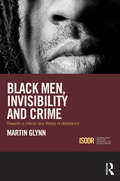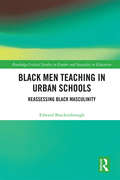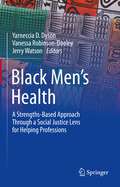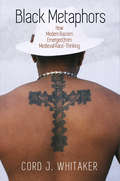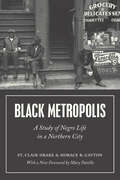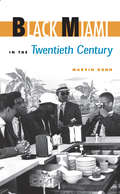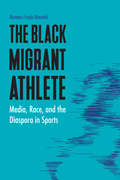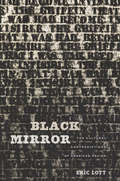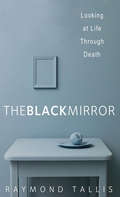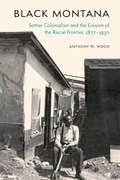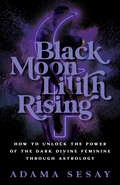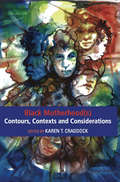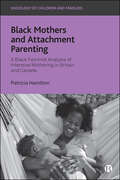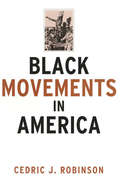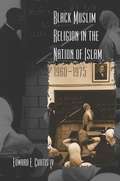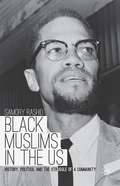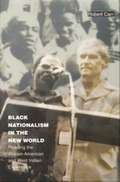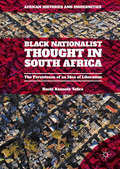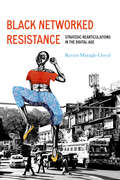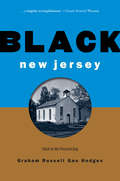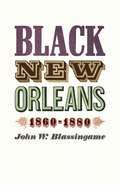- Table View
- List View
Black Men, Invisibility and Crime: Towards a Critical Race Theory of Desistance (International Series on Desistance and Rehabilitation)
by Martin GlynnPast studies have suggested that offenders desist from crime due to a range of factors, such as familial pressures, faith based interventions or financial incentives. To date, little has been written about the relationship between desistance and racialisation. This book seeks to bring much needed attention to this under-researched area of criminological inquiry. Martin Glynn builds on recent empirical research in the UK and the USA and uses Critical Race Theory as a framework for developing a fresh perspective about black men’s desistance. This book posits that the voices and collective narrative of black men offers a unique opportunity to refine current understandings of desistance. It also demonstrates how new insights can be gained by studying the ways in which elements of the desistance trajectory are racialised. This book will be of interest both to criminologists and sociologists engaged with race, racialisation, ethnicity, and criminal justice.
Black Men on Race, Gender, and Sexuality
by Devon CarbadoIn late 1995, the Million Man March drew hundreds of thousands of black men to Washington, DC, and seemed even to skeptics a powerful sign not only of black male solidarity, but also of black racial solidarity. Yet while generating a sense of community and common purpose, the Million Man March, with its deliberate exclusion of women and implicit rejection of black gay men, also highlighted one of the central faultlines in African American politics: the role of gender and sexuality in antiracist agenda. In this groundbreaking anthology, a companion to the highly successful Critical Race Feminism, Devon Carbado changes the terms of the debate over racism, gender, and sexuality in black America. The essays cover such topics as the legal construction of black male identity, domestic abuse in the black community, the enduring power of black machismo, the politics of black male/white female relationships, racial essentialism, the role of black men in black women's quest for racial equality, and the heterosexist nature of black political engagement. Featuring work by Cornel West, Huey Newton, Henry Louis Gates, Jr., A. Leon Higginbotham, Jr., Houston Baker, Marlon T. Riggs, Dwight McBride, Michael Awkward, Ishmael Reed, Derrick Bell, and many others, Devon Carbado's anthology stakes out new territory in the American racial landscape.--Critical America, A series edited by Richard Delgado and Jean Stephancic.
Black Men Teaching in Urban Schools: Reassessing Black Masculinity (Routledge Critical Studies in Gender and Sexuality in Education)
by Edward BrockenbroughThis volume follows eleven Black male teachers from an urban, predominantly Black school district to reveal a complex set of identity politics and power dynamics that complicate these teachers’ relationships with students and fellow educators. It provides new and important insights into what it means to be a Black male teacher and suggests strategies for school districts, teacher preparation programs, researchers and other stakeholders to rethink why and how we recruit and train Black male teachers for urban K-12 classrooms.
Black Men Worshipping
by Stacy C. Boyd"Black Men Worshipping" analyzes the discursive spaces where black Christian masculinity is constructed, performed, and contested in American religion and culture. It judiciously considers the anxiety that emerges from black male negotiations with constructions of blackness, maleness, and Christian embodiment. "Black Men Worshipping" places fictive literary narratives such as "Uncle Tom's Cabin" and "In My Father's House," and film narratives such as "The Green Mile" in dialogue with the non-fictive narratives of popular African American figures Bishop T. D. Jakes and Pastor Donnie McClurkin in an effort to provide a snapshot of the complex constellation of issues involved in black male Christian embodiment.
Black Men’s Health: A Strengths-Based Approach Through a Social Justice Lens for Helping Professions
by Yarneccia D. Dyson Vanessa Robinson-Dooley Jerry WatsonNow more than ever there is a need to focus on Black men's health in higher education and ensure that future practitioners are trained to ethically and culturally serve this historically oppressed community. This textbook provides practical insight and knowledge that prepare students to work with Black men and their families from a strengths-based and social justice lens. There is a dearth in the literature that discusses the prioritization of Black men’s health within the context of how they are viewed by societal approaches to engage them in research, and health programming aimed at increasing their participation in health services to decrease their morbidity and mortality rates. Much of the extant literature is over 10 years old and doesn't account for social determinants of health, perceptions of health status, as well as social justice implications that can affect the health outcomes of this historically oppressed population including structural and systemic racism as well as police brutality and gun violence.The book's 13 chapters represent a diversity of thought and perspectives of experts reflective of various disciplines and are organized in four sections:Part I - Racial Disparities and Black MenPart II - Black Masculinity Part III - Black Men in Research Part IV - Social Justice Implications for Black Men's Health Black Men’s Health serves as a core text across multiple disciplines and can be utilized in undergraduate- and graduate-level curriculums. It equips students and educators in social work, nursing, public health, and other helping professions with the knowledge and insight that can be helpful in their future experiences of working with Black men or men from other marginalized racial/ethnic groups and their families/social support systems. Scholars, practitioners, and academics in these disciplines, as well as community-based organizations who provide services to Black men and their families, state agencies, and evaluation firms with shared interests also would find this a useful resource.
Black Metaphors: How Modern Racism Emerged from Medieval Race-Thinking (The Middle Ages Series)
by Cord J. WhitakerIn the late Middle Ages, Christian conversion could wash a black person's skin white—or at least that is what happens when a black sultan converts to Christianity in the English romance King of Tars. In Black Metaphors, Cord J. Whitaker examines the rhetorical and theological moves through which blackness and whiteness became metaphors for sin and purity in the English and European Middle Ages—metaphors that guided the development of notions of race in the centuries that followed. From a modern perspective, moments like the sultan's transformation present blackness and whiteness as opposites in which each condition is forever marked as a negative or positive attribute; medieval readers were instead encouraged to remember that things that are ostensibly and strikingly different are not so separate after all, but mutually construct one another. Indeed, Whitaker observes, for medieval scholars and writers, blackness and whiteness, and the sin and salvation they represent, were held in tension, forming a unified whole.Whitaker asks not so much whether race mattered to the Middle Ages as how the Middle Ages matters to the study of race in our fraught times. Looking to the treatment of color and difference in works of rhetoric such as John of Garland's Synonyma, as well as in a range of vernacular theological and imaginative texts, including Robert Manning's Handlyng Synne, and such lesser known romances as The Turke and Sir Gawain, he illuminates the process by which one interpretation among many became established as the truth, and demonstrates how modern movements—from Black Lives Matter to the alt-right—are animated by the medieval origins of the black-white divide.
Black Metropolis: A Study of Negro Life in a Northern City
by St. Clair Drake Horace R. CaytonGround-breaking when first published in 1945, Black Metropolis remains a landmark study of race and urban life. Few studies since have been able to match its scope and magnitude, offering one of the most comprehensive looks at black life in America. Based on research conducted by Works Progress Administration field workers, it is a sweeping historical and sociological account of the people of Chicago's South Side from the 1840s through the 1930s. Its findings offer a comprehensive analysis of black migration, settlement, community structure, and black-white race relations in the first half of the twentieth century. It offers a dizzying and dynamic world filled with captivating people and startling revelations. A new foreword from sociologist Mary Pattillo places the study in modern context, updating the story with the current state of black communities in Chicago and the larger United States and exploring what this means for the future. As the country continues to struggle with race and our treatment of black lives, Black Metropolis continues to be a powerful contribution to the conversation.
Black Miami in the Twentieth Century (Florida History and Culture)
by Marvin DunnThe first book devoted to the history of African Americans in south Florida and their pivotal role in the growth and development of Miami, Black Miami in the Twentieth Century traces their triumphs, drudgery, horrors, and courage during the first 100 years of the city's history. Firsthand accounts and over 130 photographs, many of them never published before, bring to life the proud heritage of Miami's black community.Beginning with the legendary presence of black pirates on Biscayne Bay, Marvin Dunn sketches the streams of migration by which blacks came to account for nearly half the city’s voters at the turn of the century. From the birth of a new neighborhood known as "Colored Town," Dunn traces the blossoming of black businesses, churches, civic groups, and fraternal societies that made up the black community. He recounts the heyday of "Little Broadway" along Second Avenue, with photos and individual recollections that capture the richness and vitality of black Miami's golden age between the wars.A substantial portion of the book is devoted to the Miami civil rights movement, and Dunn traces the evolution of Colored Town to Overtown and the subsequent growth of Liberty City. He profiles voting rights, housing and school desegregation, and civil disturbances like the McDuffie and Lozano incidents, and analyzes the issues and leadership that molded an increasingly diverse community through decades of strife and violence. In concluding chapters, he assesses the current position of the community--its socioeconomic status, education issues, residential patterns, and business development--and considers the effect of recent waves of immigration from Latin America and the Caribbean.Dunn combines exhaustive research in regional media and archives with personal interviews of pioneer citizens and longtime residents in a work that documents as never before the life of one of the most important black communities in the United States.
The Black Migrant Athlete: Media, Race, and the Diaspora in Sports (Sports, Media, and Society)
by Munene Franjo MwanikiThe popularity and globalization of sport have led to an ever-increasing migration of black athletes from the global South to the United States and Western Europe. While the hegemonic ideology surrounding sport is that it brings diverse people together and ameliorates social divisions, sociologists of sport have shown this to be a gross simplification. Instead, sport and its narratives often reinforce and re-create stereotypes and social boundaries, especially regarding race and the prowess and the position of the black athlete. Because sport is a contested terrain for maintaining and challenging racial norms and boundaries, the black athlete has always impacted popular (white) perceptions of blackness in a global manner.The Black Migrant Athlete analyzes the construction of race in Western societies through a study of the black African migrant athlete. Munene Franjo Mwaniki presents ten black African migrant athletes as a conceptual starting point to interrogate the nuances of white supremacy and of the migrant and immigrant experience with a global perspective. By using celebrity athletes such as Hakeem Olajuwon, Dikembe Mutombo, and Catherine Ndereba as entry points into a global discourse, Mwaniki explores how these athletes are wrapped in social and cultural meanings by predominately white-owned and -dominated media organizations. Drawing from discourse analysis and cultural studies, Mwaniki examines the various power relations via media texts regarding race, gender, sexuality, class, and nationality.
Black Mirror: The Cultural Contradictions of American Racism
by Eric LottBlackness is a prized commodity in American pop culture. Marketed to white consumers, it invites whites to view themselves in a mirror of racial difference, while remaining “wholly” white. From sports to literature, film, and music to investigative journalism, Eric Lott reveals the hidden dynamics of this self-and-other racial mirroring.
The Black Mirror
by Raymond TallisIn this beautifully written personal meditation on life and living, Raymond Tallis reflects on the fundamental fact of existence: that it is finite. Inspired by E. M. Forster's thought that "Death destroys a man but the idea of it saves him," Tallis invites readers to look back on their lives from a unique standpoint: one's own future corpse. From this perspective, he shows, the world now vacated can be seen most clearly in all its richness and complexity. Tallis blends lyrical reflection, humor, and the occasional philosophical argument as he explores his own postmortem recollections. He considers the biological processes and the senses that opened up his late world and the million-nooked space in which he passed his life. His inert, dispossessed body highlights his ceaseless activity in life, the mind-boggling inventory of his possessions, and the togetherness and apartness that characterized his relationships in the material and social worlds. Tallis also touches on the idea of a posthumous life in the memories of those who outlive him. Readers who accompany Tallis as he considers his life through death will appreciate with new intensity the precariousness and preciousness of life, for here he succeeds in his endeavor to make "the shining hour" shine more brightly.
Black Montana: Settler Colonialism and the Erosion of the Racial Frontier, 1877-1930
by Anthony W. WoodToward the end of the nineteenth century, many African Americans moved westward as Greater Reconstruction came to a close. Though, along with Euro-Americans, Black settlers appropriated the land of Native Americans, sometimes even contributing to ongoing violence against Indigenous people, this migration often defied the goals of settler states in the American West. In Black Montana Anthony W. Wood explores the entanglements of race, settler colonialism, and the emergence of state and regional identity in the American West during the nineteenth and twentieth centuries. By producing conditions of social, cultural, and economic precarity that undermined Black Montanans&’ networks of kinship, community, and financial security, the state of Montana, in its capacity as a settler colony, worked to exclude the Black community that began to form inside its borders after Reconstruction.Black Montana depicts the history of Montana&’s Black community from 1877 until the 1930s, a period in western American history that represents a significant moment and unique geography in the life of the U.S. settler-colonial project.
Black Moon Lilith Rising: How to Unlock the Power of the Dark Divine Feminine Through Astrology
by Adama SesayAn exploration of the Black Moon Lilith placement in astrology—a widely searched yet underserved topic—that reclaims the misunderstood archetype of Lilith and shows you how to use her energy for empowerment and transformation.Black Moon Lilith Rising is unlike any other astrology book out there on multiple fronts: it is a comprehensive exploration of the placement of Lilith in astrology, it&’s a deep exploration into the misunderstood myth and archetype of Lilith, and it incorporates shadow work and spiritual alchemy.The book begins with an ode to Lilith, anecdotal stories surrounding the author&’s experience with the energy, the history, and mythology behind the Lilith archetype. Lilith has been demonized, known as the first rebellious, disobedient woman, but in fact she is a powerful, sovereign being. By untwisting the truth about her energy, the world can heal the suppressed feminine, balance the power dynamic, and ascend.The contents of the book contain:How Black Moon Lilith can be integrated practically for empowerment and life transformation. An in-depth astrological analysis covering Black Moon Lilith through the 12 zodiac signs and houses. Planetary and angular aspects are then layered on explaining how Lilith can affect the other energies in the birth chart in an impactful way.A guide to shadow work with Lilith and a Spiritual Alchemy practice for 13 days, as 13 is the number of the divine feminine.
Black Morocco
by Chouki El HamelBlack Morocco: A History of Slavery, Race and Islam chronicles the experiences, identity, and achievements of enslaved black people in Morocco from the sixteenth century to the beginning of the twentieth century. Chouki El Hamel argues that we cannot rely solely on Islamic ideology as the key to explain social relations and particularly the history of black slavery in the Muslim world, for this viewpoint yields an inaccurate historical record of the people, institutions, and social practices of slavery in Northwest Africa. El Hamel focuses on black Moroccans' collective experience beginning with their enslavement to serve as the loyal army of the Sultan Isma'il. By the time the Sultan died in 1727, they had become a political force, making and unmaking rulers well into the nineteenth century. The emphasis on the political history of the black army is augmented by a close examination of the continuity of black Moroccan identity through the musical and cultural practices of the Gnawa.
Black Motherhood(s) Contours, Contexts and Considerations: Contours, Contexts And Considerations
by Karen. T. CraddockThis book considers Black Motherhood through multiple and global lenses to engage the reader in an expanded reflection and to prompt further discourse on the intersection of race and gender within the construct of motherhood among Black women. With an aim to extend traditional treatments of Black motherhood that are often centered on a subordinated and struggling perspective, these essays address some of the hegemonic reality while also exploring nuance in experiences, less explored areas of subjugation, as well as pathways of resistance and resilience in spite of it. Largely focusing within domains such as narrative, identity, spirituality and sexuality, the book deftly explores black motherhood by incorporating varied arenas for discussion including: literary analysis, expressive arts, historical fiction, the African Diaspora, reproductive health, religion and social ecology.
Black Mothers and Attachment Parenting: A Black Feminist Analysis of Intensive Mothering in Britain and Canada (Sociology of Children and Families)
by Patricia HamiltonAttachment parenting is an increasingly popular style of childrearing that emphasises ‘natural’ activities such as extended breastfeeding, bedsharing and babywearing. Such parenting activities are framed as the key to addressing a variety of social ills. Parents’ choices are thus made deeply significant with the potential to guarantee the well-being of future societies. Examining black mothers’ engagements with attachment parenting, Hamilton shows the limitations of this neoliberal approach. Unique in its intersectional analysis of contemporary mothering ideologies, this outstanding book fills a gap in the literature on parenting culture studies, drawing on black feminist theorizing to analyse intensive mothering practices and policies. Black Mothers and Attachment Parenting is shortlisted for the 2021 BSA Philip Abrams Memorial Prize.
Black Movements in America
by Cedric J. RobinsonCedric Robinson traces the emergence of Black political cultures in the United States from slave resistances in the 16th and 17th centuries to the civil rights movements of the present. Drawing on the historical record, he argues that Blacks have constructed both a culture of resistance and a culture of accommodation based on the radically different experiences of slaves and free Blacks.
Black Muslim Religion in the Nation of Islam, 1960-1975
by Edward E. Curtis IVElijah Muhammad's Nation of Islam came to America's attention in the 1960s and 1970s as a radical separatist African American social and political group. But the movement was also a religious one. Edward E. Curtis IV offers the first comprehensive examination of the rituals, ethics, theologies, and religious narratives of the Nation of Islam, showing how the movement combined elements of Afro-Eurasian Islamic traditions with African American traditions to create a new form of Islamic faith.Considering everything from bean pies to religious cartoons, clothing styles to prayer rituals, Curtis explains how the practice of Islam in the movement included the disciplining and purifying of the black body, the reorientation of African American historical consciousness toward the Muslim world, an engagement with both mainstream Islamic texts and the prophecies of Elijah Muhammad, and the development of a holistic approach to political, religious, and social liberation. Curtis's analysis pushes beyond essentialist ideas about what it means to be Muslim and offers a view of the importance of local processes in identity formation and the appropriation of Islamic traditions.
Black Muslims in the US
by Samory RashidBlack Muslims in the U. S. seeks to address deficiencies in current scholarship about black Muslims in American society, from examining the origins of Islam among African-Americans to acknowledging the influential role that black Muslims play in contemporary U. S. society.
Black Nationalism in the New World: Reading the African-American and West Indian Experience
by Robert CarrFrom nineteenth-century black nationalist writer Martin Delany through the rise of Jim Crow, the 1937 riots in Trinidad, and the achievement of Independence in the West Indies, up to the present era of globalization, Black Nationalism in the New World explores the paths taken by black nationalism in the United States and the Caribbean. Bringing to bear a comparative, diasporic perspective, Robert Carr examines the complex roles race, gender, sexuality, and history have played in the formation of black national identities in the U. S. and Caribbean--particularly in Jamaica, Trinidad, and Guyana--over the past two centuries. He shows how nationalism begins as an impulse emanating "upwards" from the bottom of the social and economic spectrum and discusses the implications of this phenomenon for understanding democracy and nationalism. Black Nationalism in the New World combines geography, political economy, and subaltern studies in readings of noncanonical literary works, which in turn illuminate debates over African-American and West Indian culture, identity, and politics. In addition to Martin Delany's Blake, or the Huts of America, Carr focuses on Pauline Hopkins's Contending Forces; Crown Jewel, R. A. C. de Boissière's novel of the Trinidadian revolt against British rule; Wilson Harris's Guyana Quartet; the writings of the Oakland Black Panthers--particularly Huey Newton, Bobby Seale, and Eldridge Cleaver; the gay novella Just Being Guys Together; and Lionheart Gal, a collection of patois testimonials assembled by Sistren, a radical Jamaican women's theater group active in the '80s. With its comparative approach, broad historical sweep, and use of texts not well known in the United States, Black Nationalism in the New World extends the work of such theorists as Homi Bhabha, Paul Gilroy, and Nell Irwin Painter. It will be necessary reading for those interested in African American studies, Caribbean studies, cultural studies, women's studies, and American studies.
Black Nationalist Thought in South Africa: The Persistence of an Idea of Liberation (African Histories and Modernities)
by Hashi Kenneth TafiraThisbook maintains that South Africa, despite the official end of apartheid in1994, remains steeped in the interstices of coloniality. The author looks atthe Black Nationalist thought in South Africa and its genealogy. Colonialmodernity and coloniality of power and their equally sinister accessories, war,murder, rape and genocide have had a lasting impact onto those unfortunateenough to receive such ghastly visitations. Tafira explores a range of topicsincluding youth political movement, the social construction of blackness inAzania, and conceptualizations from the Black Liberation Movement.
Black Neighbors: Race and the Limits of Reform in the American Settlement House Movement, 1890-1945
by Elisabeth Lasch-QuinnBy 1910, about 400 settlement houses had been established in U.S. cities to help European immigrants adjust to life in America. As African Americans migrated to the cities, however, few settlements made a whole-hearted attempt to include them. In this book the author tries to determine why African American migrants were treated differently from European whites. She also describes a number of church-based programs in southern cities which were highly successful in helping black families. Most of these programs were created by black women, or by black and white women working in partnership.
Black Networked Resistance: Strategic Rearticulations in the Digital Age
by Raven Simone Maragh-LloydBlack Networked Resistance explores the creative range of Black digital users and their responses to varying forms of oppression, utilizing cultural, communicative, political, and technological threads both on and offline. Raven Maragh-Lloyd demonstrates how Black users strategically rearticulate their responses to oppression in ways that highlight Black publics’ historically rich traditions and reveal the shifting nature of both dominance and resistance, particularly in the digital age. Through case studies and interviews, Maragh-Lloyd reveals the malleable ways resistance can take shape and the ways Black users artfully demonstrate such modifications of resistance through strategies of survival, reprieve, and community online. Each chapter grounds itself in a resistance strategy, such as Black humor, care, or archiving, to show the ways that Black publics reshape strategies of resistance over time and across media platforms. Linking singular digital resistance movements while arguing for Black publics as strategic content creators who connect resistance strategies from our past to suit our present needs, Black Networked Resistance encourages readers to create and cultivate lasting communities necessary for social and political change by imagining a future of joy, community, and agency through their digital media practices.
Black New Jersey: 1664 to the Present Day
by Graham Russell HodgesBlack New Jersey tells the rich and complex story of the African American community’s remarkable accomplishments and the colossal obstacles they faced along the way. Drawing from rare archives, historian Graham Russell Gao Hodges brings to life the courageous black men and women who fought for their freedom and eventually built a sturdy and substantial middle class. He explores how the state’s unique mix of religious, artistic, and cultural traditions have helped to produce such world-renowned figures as Paul Robeson, Cory Booker, and Queen Latifah, as well as a host of lesser-known but equally influential New Jersey natives.
Black New Orleans, 1860–1880: 1860-1880
by John W. BlassingameReissued for the first time in over thirty years, Black New Orleans explores the twenty-year period in which the city’s black population more than doubled. Meticulously researched and replete with archival illustrations from newspapers and rare periodicals, John W. Blassingame’s groundbreaking history offers a unique look at the economic and social life of black people in New Orleans during Reconstruction. Not a conventional political treatment, Blassingame’s history instead emphasizes the educational, religious, cultural, and economic activities of African Americans during the late nineteenth century. “Blending historical and sociological perspectives, and drawing with skill and imagination upon a variety of sources, [Blassingame] offers fresh insights into an oft-studied period of Southern history. . . . In both time and place the author has chosen an extraordinarily revealing vantage point from which to view his subject. ”—Neil R. McMillen, American Historical Review
